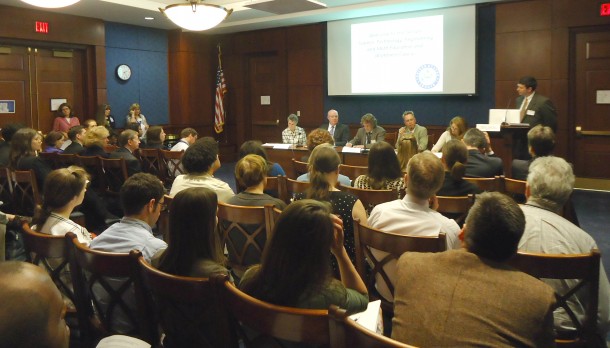
On May 20th 2013, the STEM Education and Workforce Caucus Inaugural Briefing entitled “Stakeholder Responses to the President’s FY14 STEM Proposal” brought a packed room of nonprofit, government, academic and industry professionals to discuss STEM education gaps, federal STEM program consolidation, and STEM mentorship.
The panel, held at the US Capitol Building Senate Briefing Room, included Susan Lavrakas, Director of Workforce at Aerospace Industries Association (AIA), Ed Swallow, Chair of the STEM Workforce Division at the National Defense Industrial Association (NDIA) and Vice President of Business Development for the Federal and Defense Technologies Division at Northrop Grumman, Philip Sadler, Director of Science Education Harvard-Smithsonian Center for Astrophysics, James Brown, Director of the STEM Education Coalition, and Heather Gonzalez, specialist in Science and Technology Policy in the Resources, Science and Industry Division of the Congressional Research Service. Steven Pruitt, Senior Vice President for Content, Research and Development at Achieve, Inc. served as moderator.
Each panelist opened up the discussion by describing the state of the nation’s STEM education outreach programs and how FY14 will significantly consolidate current STEM-related initiatives. According to Gonzalez, the Department of Education (DoEd), National Science Foundation (NSF) and the Department of Health and Human Services (HHS) are the top federal agencies that support STEM education and outreach initiatives. All panelists agreed that the FY14 will include the elimination of the many one-off STEM initiatives across small and large government agencies in hopes of bringing a more unified federal outreach program. Additions to STEM education funding in FY14 are focused on “lead agencies” such as DoEd for K-12, NSF for Undergraduate and the Smithsonian Institute for informal STEM Education.
Much was discussed regarding the STEM education “pipeline” in K-12 learning and where the “leakage is” regarding the persistence and performance of students when learning math and science.
Swallow said, “What we have discovered is that it is 5th grade. 5th grade is where it is broken. This is because students, parents, sometimes guidance counselors, sometimes teachers, sometimes well meaning, and sometimes not, decide what kind of math courses they are going to put their student in during middle school. And, if you don’t take algebra in 8th grade, you are not graduating in four years with a degree in science, engineering or math. As expensive as college is right now, there are not too many people that want to pay for a five-year program.”
Swallow went on to say, “You can see the leakage starts at 5th grade and it gets worse along the way. The most disturbing fact that everyone should really look at is that while 17% of the high school graduates are both proficient in STEM and interested in STEM, there is another 26% that are interested in STEM, but are not proficient. Very few of them end of up in the STEM workforce…not being proficient comes from not taking algebra in 8th grade. It is getting 5th graders excited about math, getting them somewhat proficient, and then pushing them into that [field].
The most recent data that I have is that only 21% of 8th graders were taking algebra, or have taken it. That is our STEM pipeline folks – 21%. The rest of them have an uphill battle.”
Lavrakas took a more social-economic view regarding why the US is not a top producer of STEM college graduates.
“This is a huge social and cultural issue; it is not a technical issue. It gets down to having parents understand why it is important for their child and for their country to do well in STEM education and workforce preparation,” added Lavrakas.
Earlier in the program, Lavrakas noted the importance of STEM mentors, both in classrooms and out of school, in bringing exposure and direction to children.
“There is a danger in destroying the powerful connections and potential for forging relationships between subject matter experts in the mission agencies and students with an interest in their fields. Our experience indicates that STEM mentors and role models play a vital role in inspiring students to envision and undertake the demanding pathways to future careers in our industry and related fields. Consequently, we are looking to maximize opportunities for students to interact and develop relationships with the engineers and other technical professionals in our companies.
“This is especially necessary because many teachers have no exposure to or no idea what jobs in our industry involve and what is required in terms of advance preparation. Various programs play a similarly vital role in attracting young people into important work at federal departments and agencies. We cannot afford to lose that effectiveness, so decisions to move or eliminate their targeted outreach should not be implemented without great scrutiny and effort to maintain the fabric of opportunities for youth to engage with subject matter experts,” Lavrakas stated.
An underlying theme throughout the hour and half program was that there is a great need for federal and national STEM initiatives to be catered to local math and science programs.
“There is not a one size fits all answer…if you look at Thomas Jefferson High School for Science and Technology (TJHSST)…you cannot replicate this in your district. Its success is a part of a partnership with the local business community, it has the support for being a different model high school from the Board of Education that overseas it….A big aspect of the pipeline problem is that our education system is really not that flexible…The focus should not be on the dollars or size of federal footprint, it is about making states more responsive to these needs. A more rigorously flexible model to replicate schools is needed,” said Brown.
Read the full NDIA report regarding the importance of 5th and 8th grade science and math education here.
We interviewed Lavrakas earlier this year about the “secret sauce” in guiding young people to be successful in their future STEM careers.


